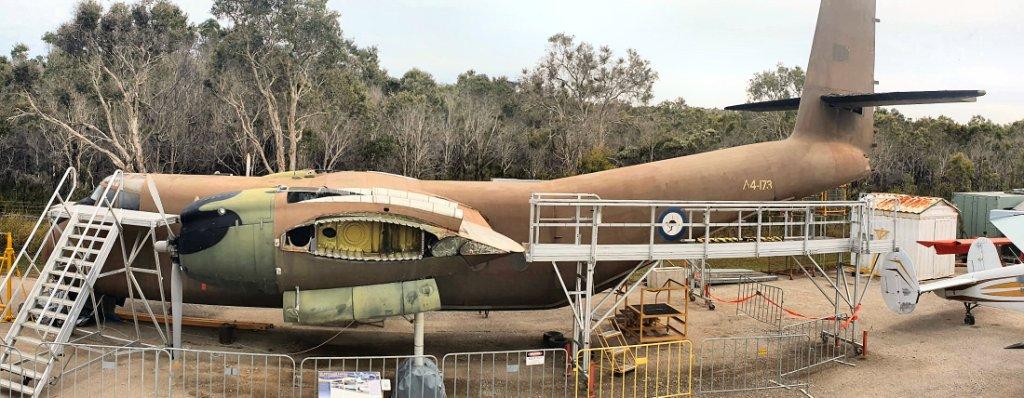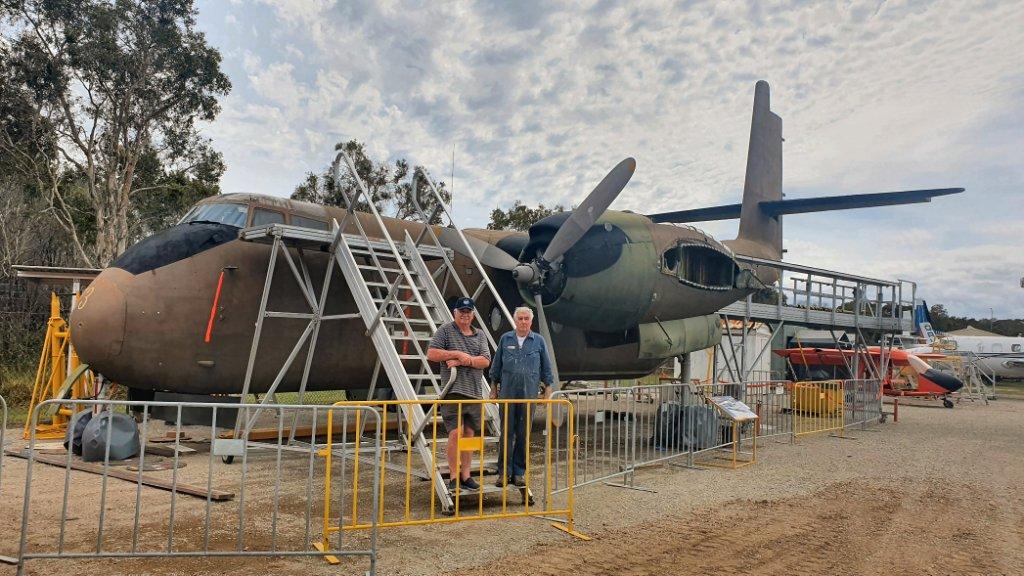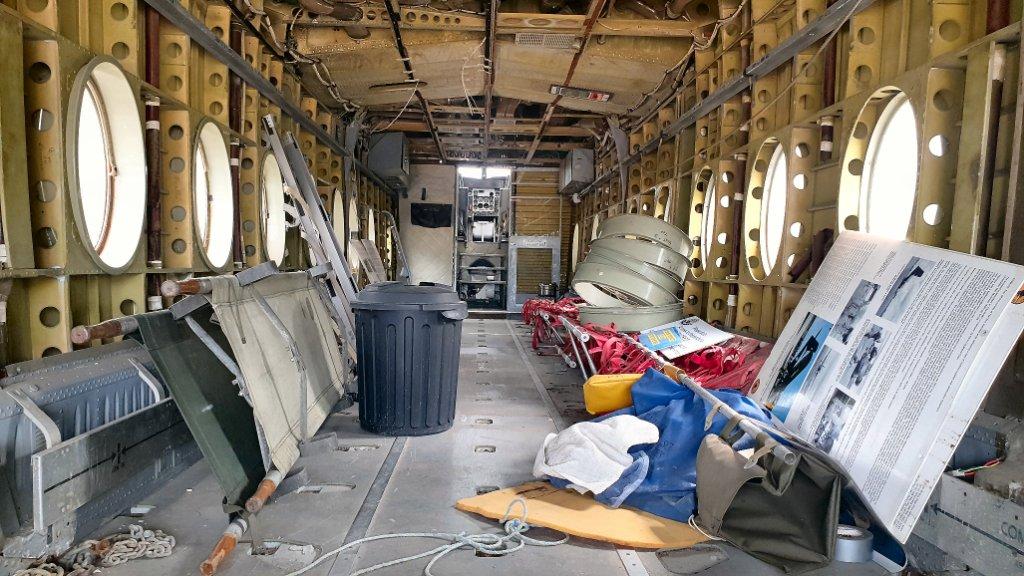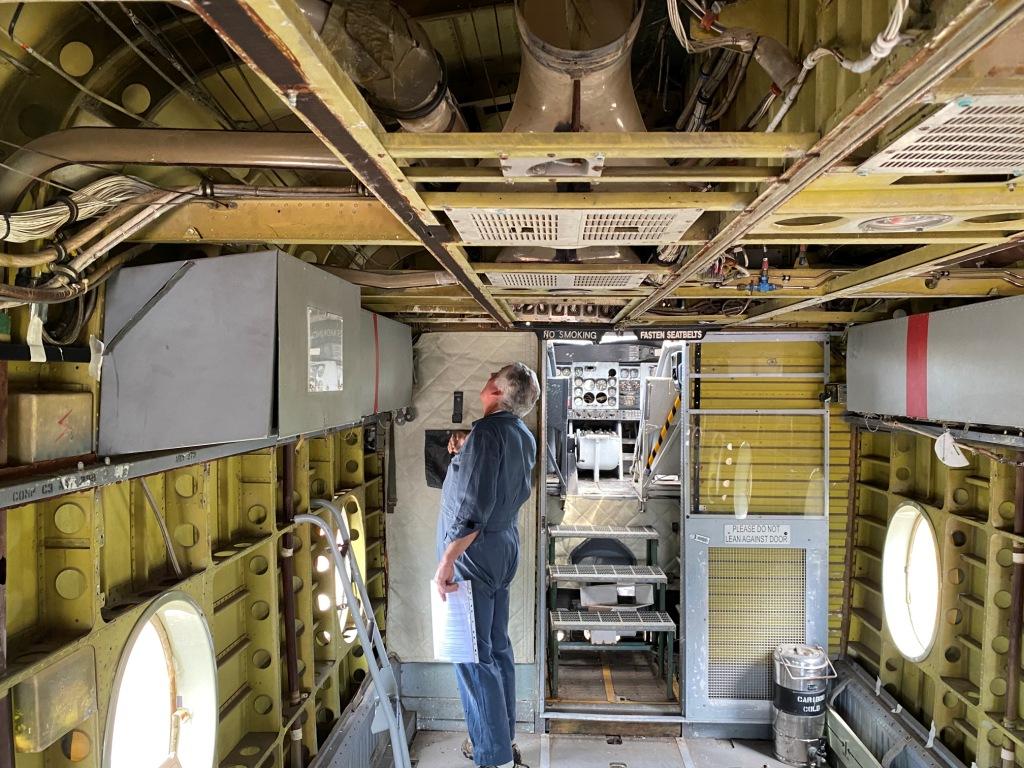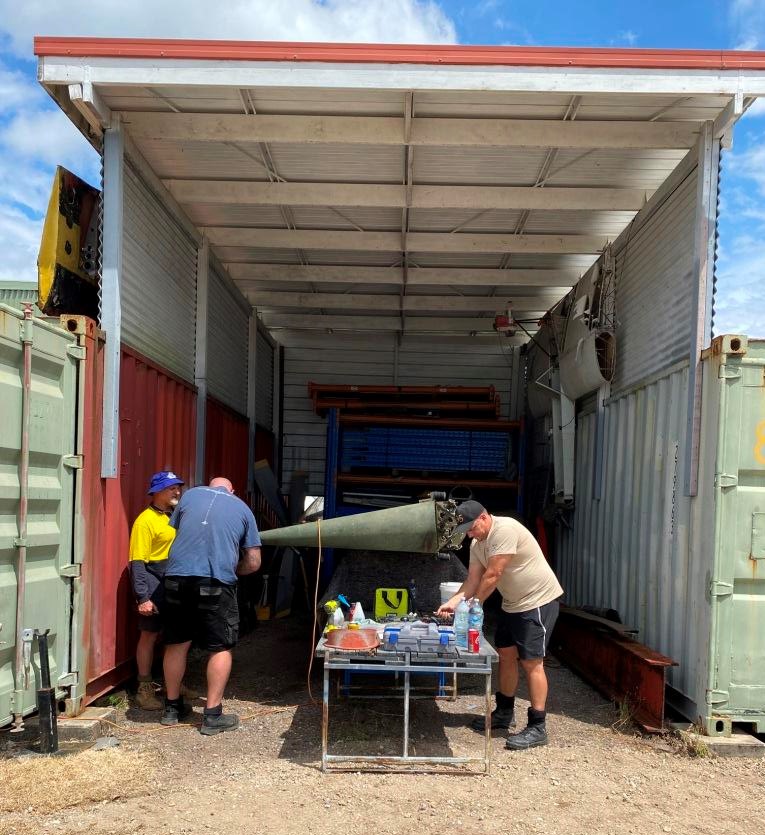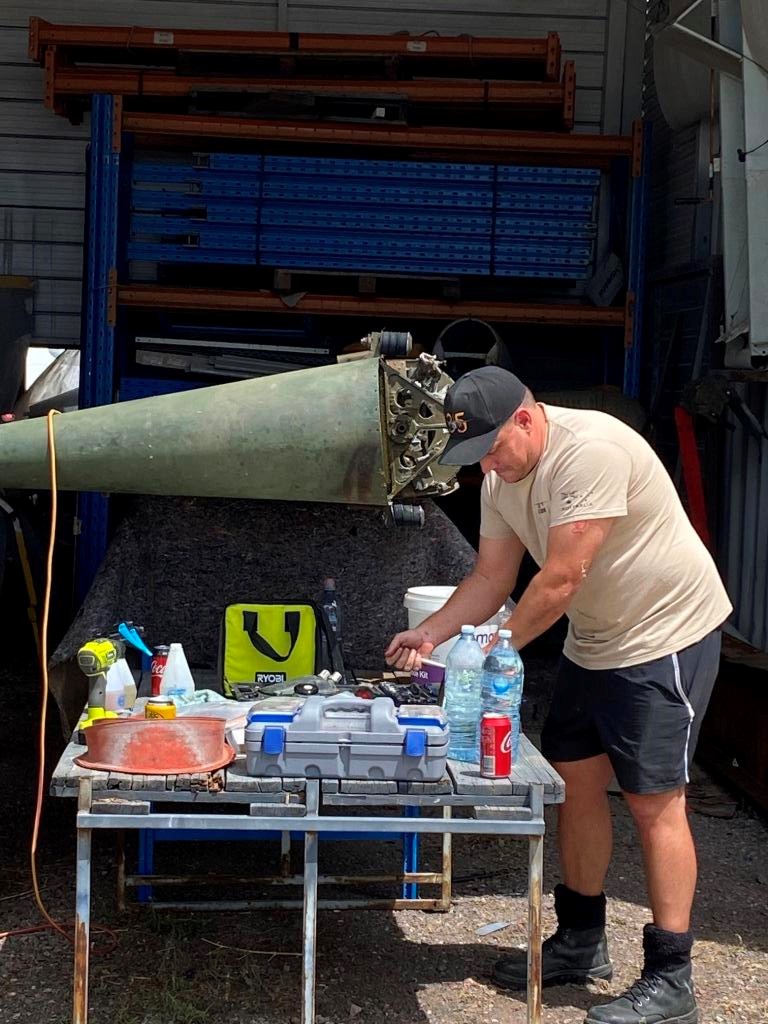
|
Vol 75 |
Page 13 |
Privacy Policy | Editorial Policy | Profit Policy | Join the Association | List of Members | Contact us | Index | Links
Back Go to page: 1 2 3 4 5 6 7 8 9 10 11 12 13 14 15 16 17 18 19 20 Forward
Some of the pics on this page have been crunched to allow the page to open quicker - you can get the HD version by clicking the pic.
Contents:
Caribou A4-173 damage at the QAM.
Caribou A4-173.
The Caribou is a twin-engined light tactical transport aircraft with rear-opening ramp doors to allow rapid loading and unloading. The prototype first flew on the 30th July 1958. Eighteen aircraft were ordered for the RAAF in May 1963 and the first aircraft, A4-134, was handed over at the DHC plant at Downsview, near Toronto, Canada, on the 25th February 1964. Three aircraft were then ferried by No 38 Squadron crews 25,700 km to Australia, via the Atlantic, Europe and Indian Ocean, arriving at Richmond on the 22nd April 1964. The initial 18 aircraft were serialled with scattered numbers between A4-134 and A4-210.
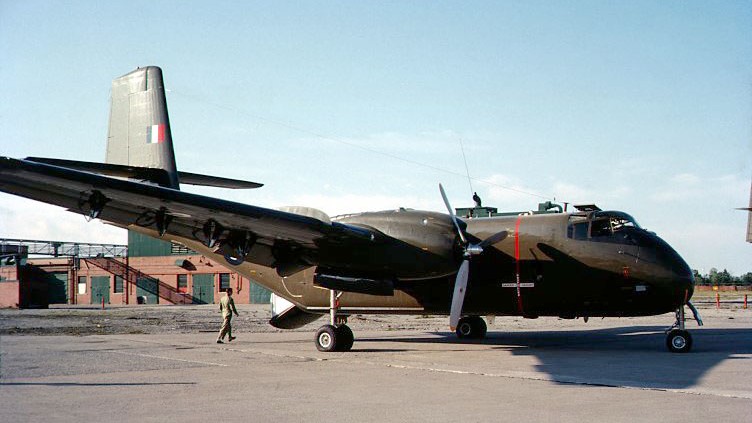
In July 1964, three aircraft on ferry from Canada to Richmond were diverted from Butterworth to South Vietnam. These aircraft were A4-171, A4-179 and A4-185. The RAAF Transport Flight Vietnam (RTFV) was formed on the 20th July and in August these three aircraft were joined by a further three, A4-173, A4-191 and A4-193. This was not a diversion as the crews of the second lot of 3 aircraft knew they were taking these aircraft from Canada to Vung Tau when they were briefed at Richmond. In March 1965 a seventh aircraft, A4-210, was added and in June 1966 RTFV became No 35 Squadron.
Caribou A4-173, one of the second flight of 3 aircraft diverted to Vung Tau, has had a very chequered career. It was delivered out of order because of manufacturing problems - on the ferry flight she had an undercarriage problem where the gear would not retract until a few minutes had elapsed; it was eventually fixed at Vung Tau and resulted in a piece of cleaning rag in the strut (wasn't extending properly so the squat switch would not allow retraction) - 173 was a bit of a lemon from day one.
In May 1965, A4-173 landed short and was extensively damaged at Hai Yen, Vietnam while delivering a load of medical supplies and construction equipment. Hai Yen was a fortified settlement on the Camau peninsula which had recently been attacked by the Viet Cong. The airstrip was very short and the Caribou clipped its nosewheel on the runway’s edge on touchdown. As one of the pilots later recalled: ‘we rediscovered the principle that an undercarriage designed to retract forward causes considerable alteration to the airframe when it is forced to retract rearwards’. Although none of the crew was injured, a wing was torn off the aircraft and the undercarriage and one engine was damaged. A detachment of ground crew were flown to the crash site to undertake a major repair job. When completed, the machine was flown back to Vung Tau at reduced speed with Squadron Leader Harvey at the controls. The recovery of A4-173 was a tribute to the skill and dedication of the flight’s ground staff.
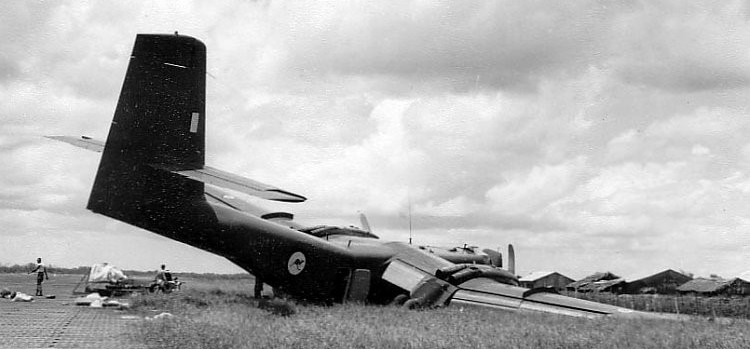
The team deployed to carry out the necessary repairs was required to undertake the effort in the open without workshop facilities. The place was under enemy attack each night during their four-day stay, forcing them to withdraw inside the settlement and to leave the aircraft to its chances. Not assisting the recovery effort, either, was further damage caused when an American supply plane delivering ammunition by parachute dropped one case through the Caribou’s wing. This necessitated a new wing being obtained from American sources and flown by helicopter to Hai Yen, where it was fitted. As a consequence, when A4-173 eventually took off it sported a mixture of US Army and RAAF markings. Without the courage, fortitude and technical competence of the ground personnel – and, as Harvey noted, ‘the generous support and co-operation given by the United States Army’ – the aircraft would simply have been written off."
Then on the 16th August 1966, it was extensively damaged in a landing accident at Ba To while delivering building supplies to a special forces camp. This accident was very similar to the Hai Yen accident which damaged the right side of the aircraft. The Ba To accident damaged the left side!
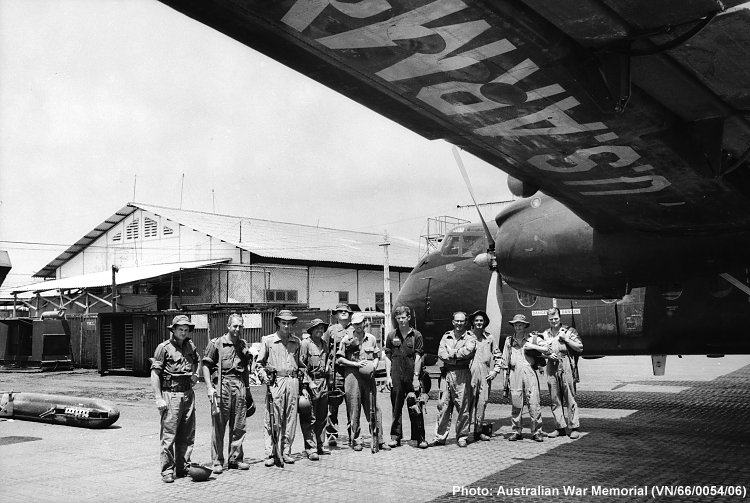
A party of ground staff was immediately flown in under Wing Commander Charles Melchert, the commanding officer, to make an attempt at recovery - an undertaking of considerable urgency since the camp was under direct threat of Viet Cong attack, including from mortar fire. To make A4-173 flyable it was necessary for the team to repair or change the wing, flaps and aileron, engine, propeller and undercarriage, as well as the nose.
Ten days later the aircraft was able to be flown back to base by the commanding officer, albeit with its undercarriage chained into position. Several clashes had taken place while the ground crew were at the camp (eight enemy being killed during one night), but an attack on the airfield later in the day of A4-173's departure would have seen its certain destruction. Return to Vung Tau marked the beginning of six months of hard work by the unit's engineering staff to get the Caribou fully serviceable again. One of Melchert's last official duties before handing over command to Squadron Leader Anthony. John Fookes in March 1967 was to test fly A4-173 after its restoration (see HERE).
On the 19th Feb 1972, A4-173 left Vietnam and arrived Richmond on the 26th Feb 1972 where it operated for some years until in July 1976 it was re-positioned to Townsville along with A4-159 and A4-234 where it operated until Feb 1988 when it was returned to Richmond and was finally retired in 1990.
In October 2001 it was stripped of all components and sold to the QAM. The fuselage was cut into 2 parts, with the rear section first trucked to the QAM with the remainder arriving in April 2002. Wings, fin and tailplane were obtained from A4-164 and arrived at the museum in Oct 2002.
It took the volunteers at the museum many months to put her back together and finally after thousands and thousands of man hours A4-173 took pride of place and was on display and enjoyed by hundreds of visitors.
Unfortunately, a while ago a huge storm went through the Caloundra region and caused considerable damage to the old girl. She was towed from her prominent position to the rear of the museum where she was roped off and stood for some time awaiting restoration once again.
The RTFV-35Sqn Association got to hear about the plight of old 173 and as it was an aircraft dear to their hearts, all had flown in her, had worked on her, some had even put her back together in Vietnam, the Museum was approached to see if they needed a hand to give her another life. This offer was accepted and on the two days, 28th and 29th Sept a few blokes from the Association along with a couple of serving blokes from 35Sqn at Amberley, tossed in and helped the museum with the big job.
Trev Benneworth and John McDougall.
The interior of the aircraft was removed for cleaning. Run your mouse over the pic to see what is should look like. (You can click for a bigger view)
John McDougall, who can still fit into his overalls, inspecting some of the damage.
Matthew Burgoyne and Craig Fenton, both from 35Sqn at Amberley, working on the rudder.
Both blokes were very warmly welcomed by the Museum
Craig Fenton, playing Sumpie, attacking one of the engine magnetos. Craig reckoned it was great working on an aircraft again with oily round engines.
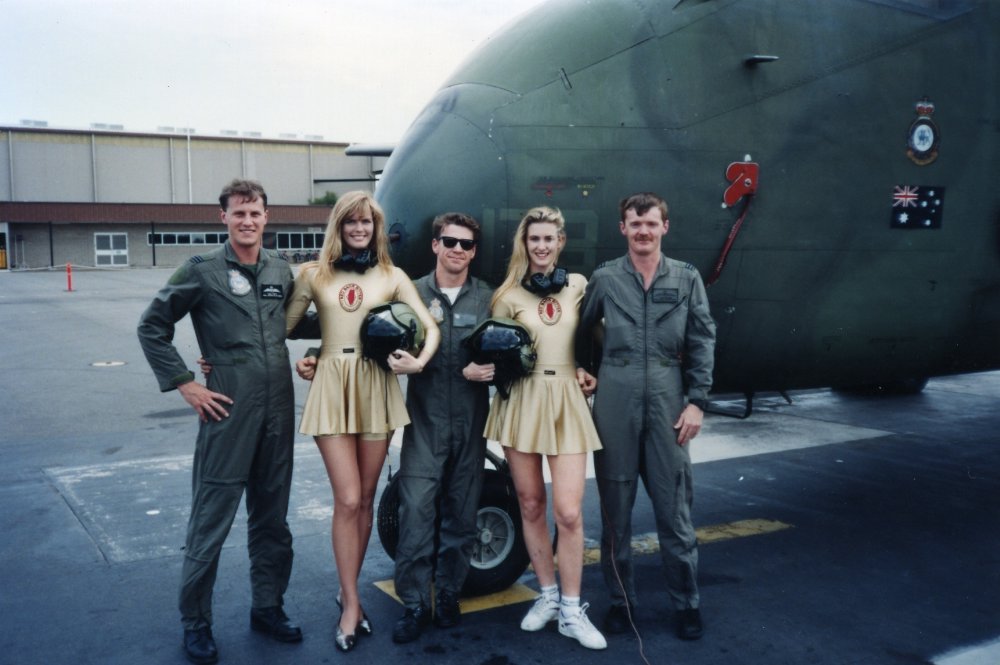
173 in happier times – if you look closely you will see an aircraft in there somewhere. (Bloke in the middle can't believe his good luck!)
The old girl needs lots of work before she’s put back in her rightful place on display but the museum does not have the staff to devote to it exclusively. That’s where we can help. If you’d like to get back into the game, bung on the blue overalls and help put her right once again, please click HERE, fill in the form and get it back to the RTFV-35Sqn Assoc.

MIRAGE METAMORPHOSIS
By Brian Weston
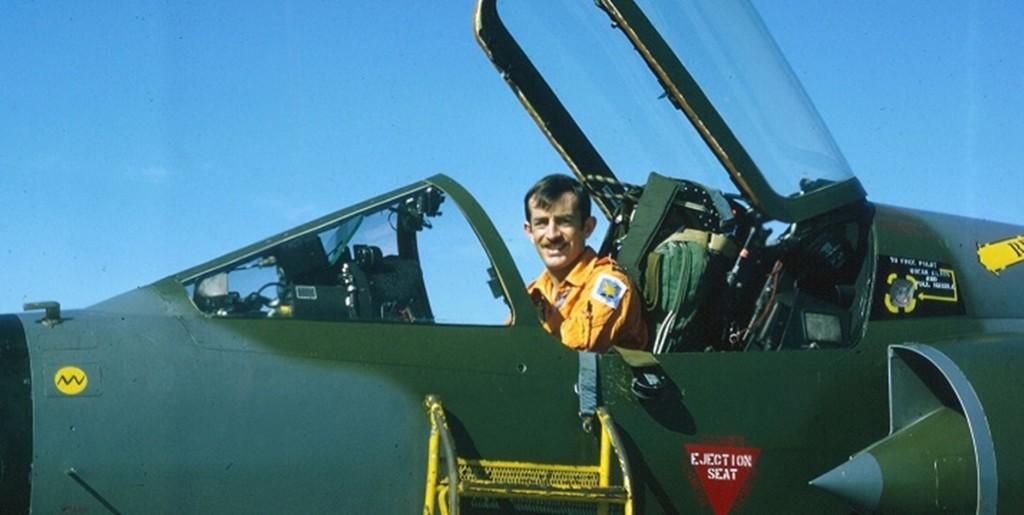
AVM (Ret'd) Brian Weston (who clocked up well over 2,000 hours as a Mirage pilot and served in 3SQN from July 1970 to September 1972) has sent in some nice photos of what he witnessed of 3SQN’s various changes of “plumage” in the late ‘60s and early ‘70s.He was also the Sqn’s Nav Oficer.
When 3SQN re-formed as a Mirage squadron, it received the Mirage IIIOA (attack) model. These were the last 50 Mirages to come off the line, with the first 50 having been Mirage IIIOF (fighter). The earlier OF aircraft were painted silver and were later upgraded to OA with radar, doppler, radio altimeter, avionic mods, paint, etc.
As the first squadron to receive the ground-attack (GA) capable Mirage, 3SQN was given the role of developing GA tactics. Rather than being a 100% air defence (AD) squadron or a 50/50 AD/GA squadron, 3SQN was formally tasked as being an 80% GA squadron with only 20% of its flying allocated to AD work. In accordance with that directive, the Mirage IIIOAs were painted in a heavy green/olive (jungle) camouflage scheme; these Mirages were referred to as “lizards”.
3SQN deployed to Butterworth in February 1969.
When 3SQN went to Butterworth it took the very last Mirage IIIOAs, the ones that had the extra 55 gallons of fuel built into the leading edges of the wings. This took place concurrently with the return of 77SQN Sabres to Williamtown and with the deployment of ten refurbished Avon Sabres to Butterworth as a gift to the RMAF. (I flew one of those Sabres to Butterworth).
As for the 3SQN paint scheme, although the Squadron had adopted the frill-necked lizard as its (unofficial) logo, the squadron’s Mirages remained unadorned. Only the 3SQN badge (an official RAAF decal) was affixed to the left side of the aircraft nose.
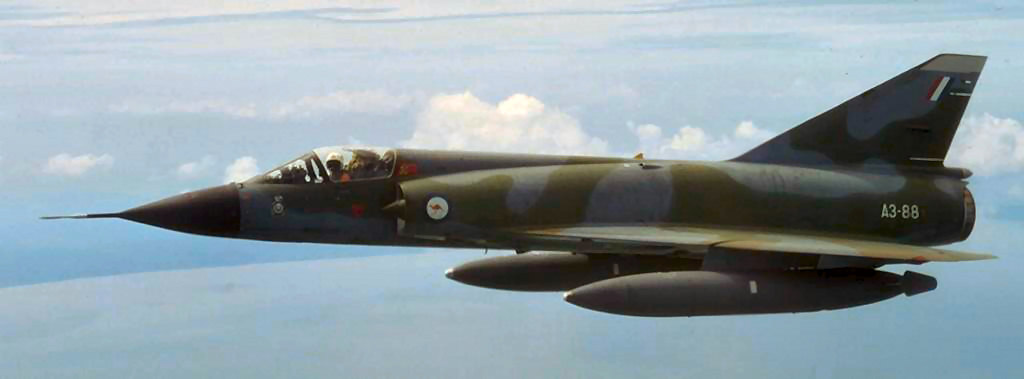
1970. No tail decoration.
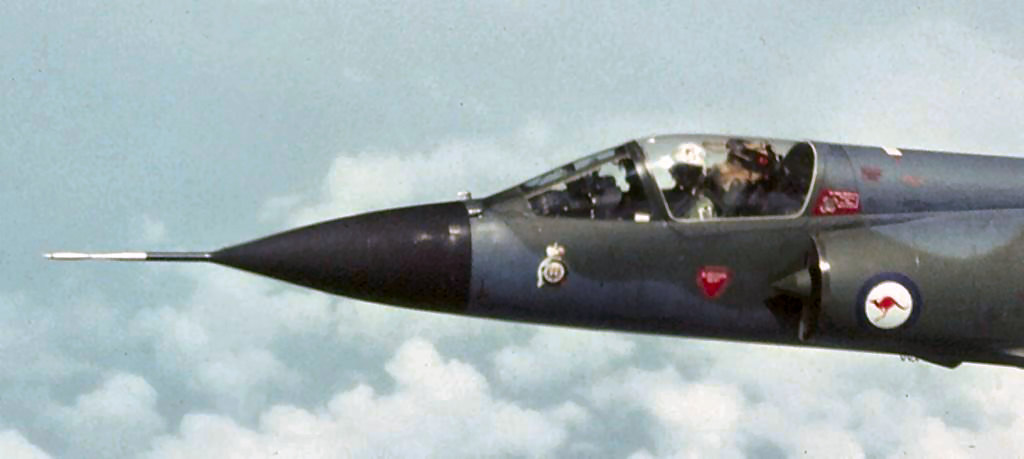
The 3SQN badge below the windscreen.
This example seems to have had a peeling leading-edge tamped down with “1,000 mph tape”, however, the pilots placed the “frill-necked lizard sitting inside the orange numeral 3” on their helmet visors, and elsewhere around the place.
This 3SQN scheme remained in use from 1969 until January 1971.
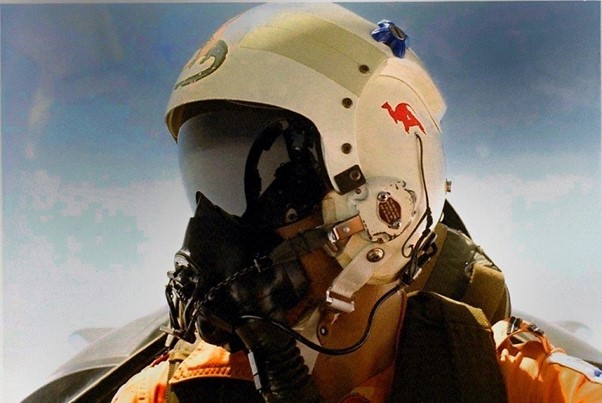
Brian’s ‘selfie’ (taken long before they were fashionable) in a ‘lizard-decaled’ helmet, en route to Tengah on the standard flight plan of ‘direct’ heading (141 deg magnetic) at 41,000 feet.
In January 1971, it was decided that 3SQN should “dress up” its aircraft a little more. There were lots of suggestions including trying to develop the earlier 3SQN schemes from Sabres and Mustangs but the deciding factor was that the RAAF Engineering fraternity did not want a tailored scheme for each squadron; it wanted a largely standardised scheme – to make things easy for the 478 (and 481) Maintenance Sqn paint shops – and not to have too much repainting of aircraft when Mirages were moved from one squadron to another.
As the paint shops already had the “three dart” template used on the tails of 75SQN, 76SQN and 2OCU aircraft, 3SQN was asked (told) to work up something using the existing “three dart” tail template. It was painted in orange and black for 3SQN; as distinct from black and white (75SQN), red and black (76SQN) and yellow and black (2OCU).
The “lizard” was added as the central tail motif, inside the “three dart” tail flash.
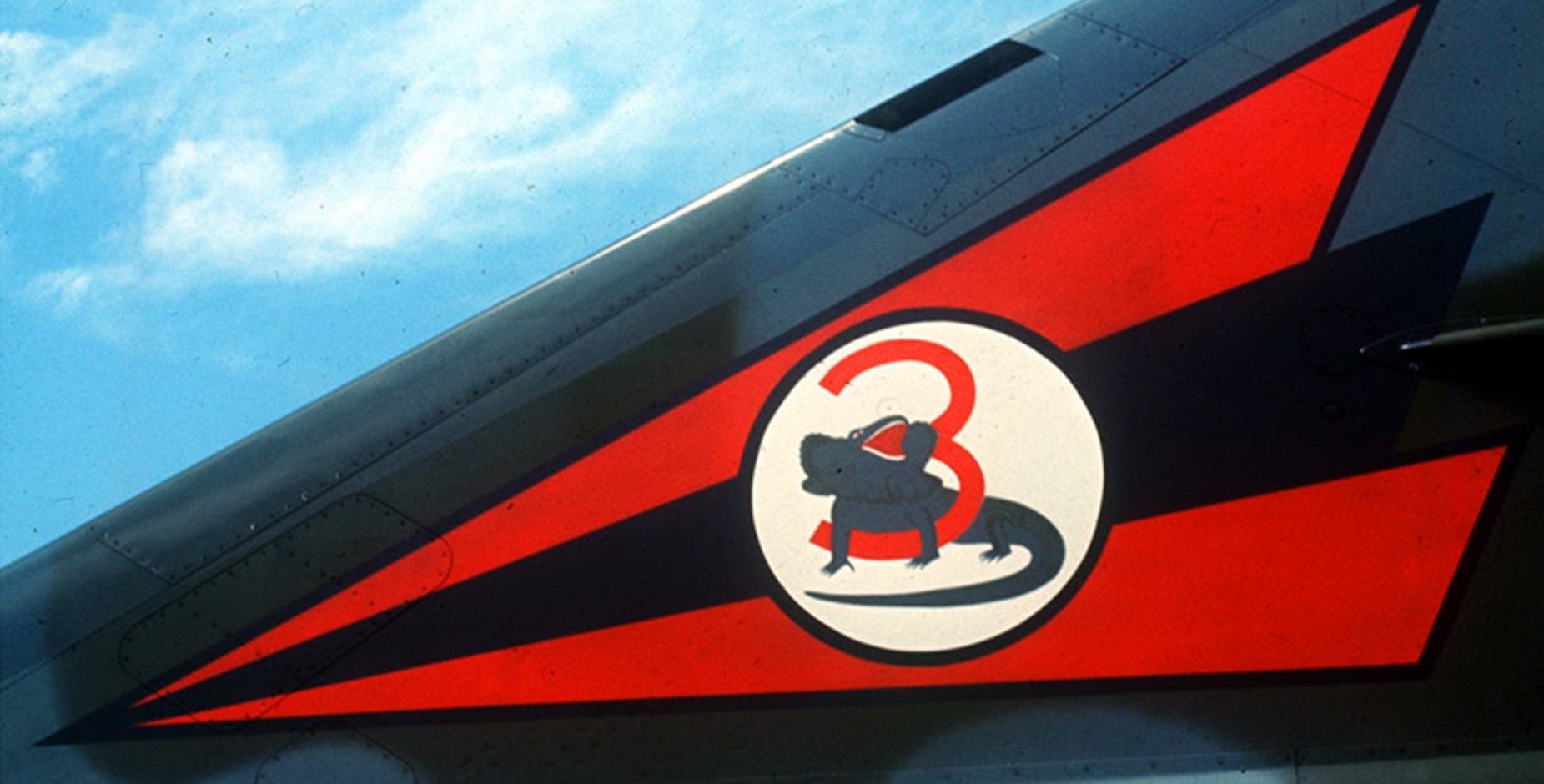
Lizard Tail Decoration, 1971.
The 3SQN badge (an official RAAF decal) remained affixed to the left side of the aircraft nose. This 3SQN scheme remained in use from January 1971 until early 1972.
In January 1972, pressure came upon 3SQN to cast away its unofficial “frill-necked lizard” logo. Indeed, an official dictum was issued to all RAAF squadrons to use only the motifs from their official squadron badges. That meant 3SQN had to use the “flaming grenade and fleur-de-lis” on the tailfin.
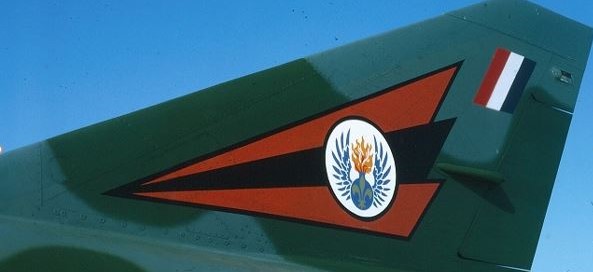
The use of the official 3SQN Badge decal on the left side of the nose was also discontinued, as they tended to tear off at high speed!. This paint scheme remained in use from early 1972 until much later.
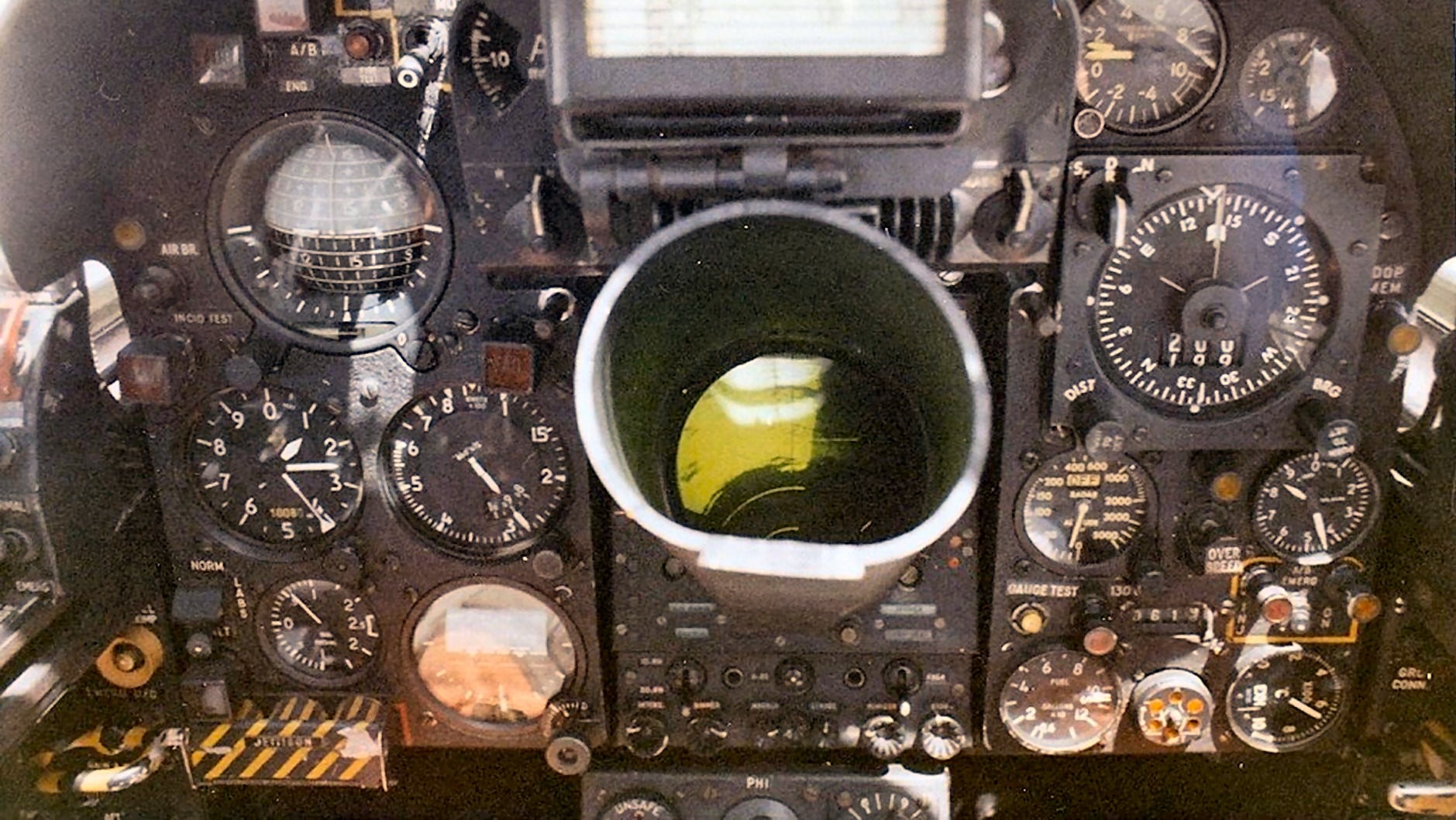
High Tech! The Mirage cockpit.
This instrumentation allowed the 'Lizards' to navigate alone at high-speed and low level, at night or in bad weather. YEAH??
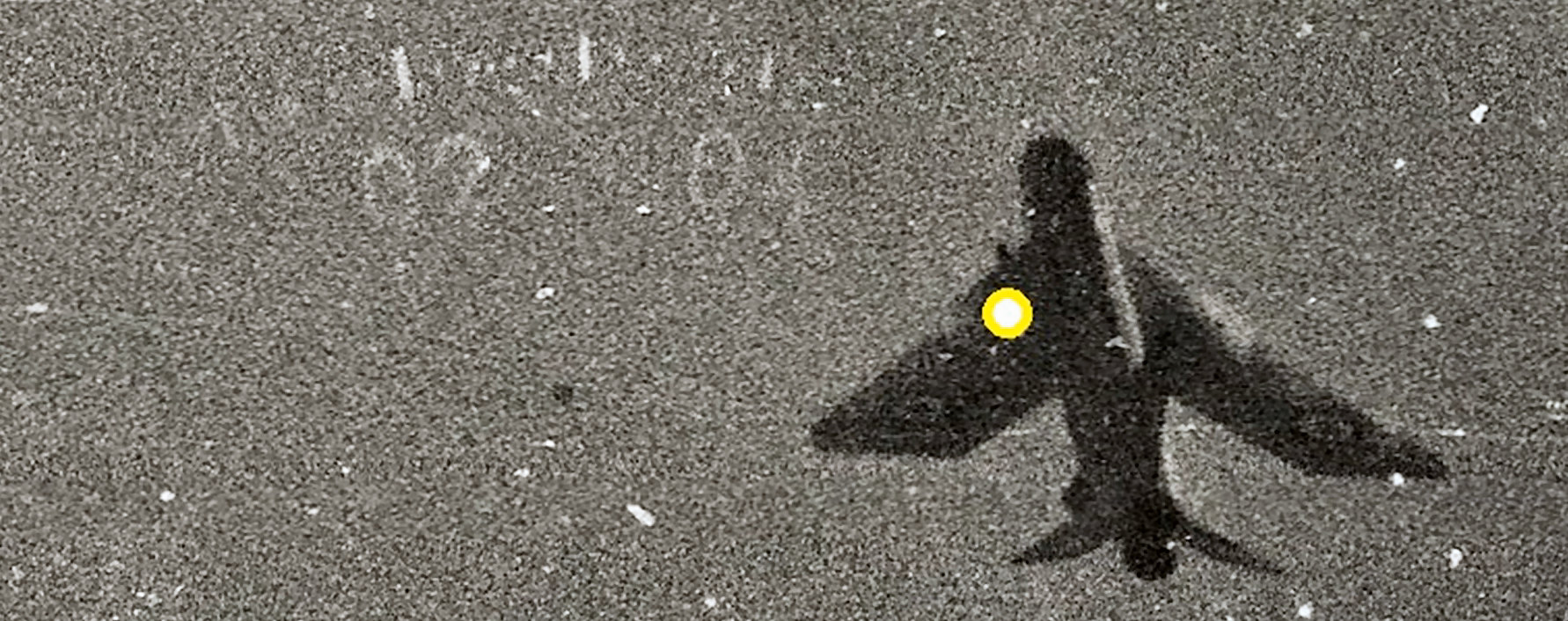
Lizard beats Lightning…
A 74SQN RAF Lightning F6 being embarrassed in Brian’s gunsight. (Taken during a regular 'Tiger Rag' deployment to RAF Tengah, before the Brits withdrew to ‘East of Suez’.)
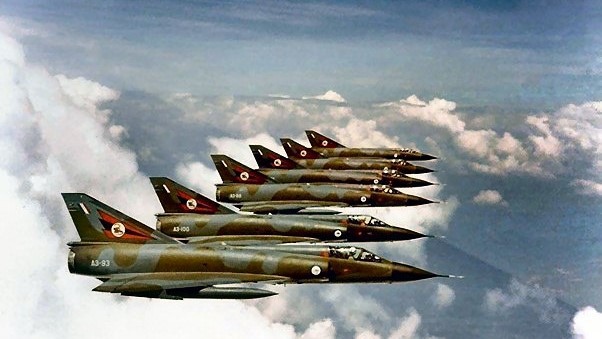
Brian writes: “On 27 August 1971, 3SQN marked the disbandment of RAF Western Hill [Penang] with a six-ship flypast. Western Hill had many RAAF personnel on strength and its disbandment was a consequence of Britain's withdrawal from ‘East of Suez’. I took the photo from the back seat of A3-107, with Rod Heideman driving. - This photo ended up on the wall of Chief of Air Staff McNAMARA's office.”
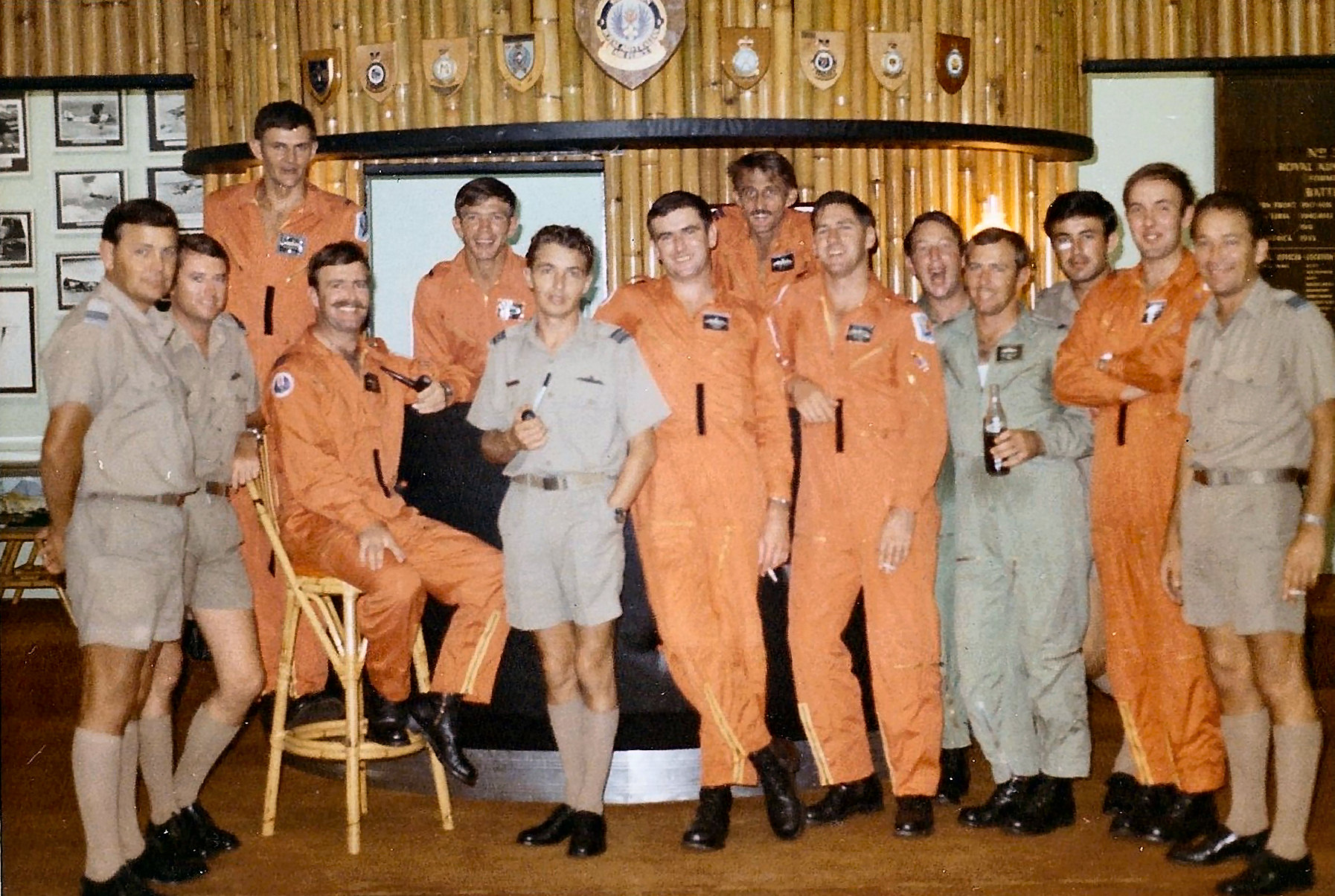
The pilots in the 3SQN Butterworth crewroom after the Western Hill flypast. The "international orange" flight-suits matched the Squadron colour!
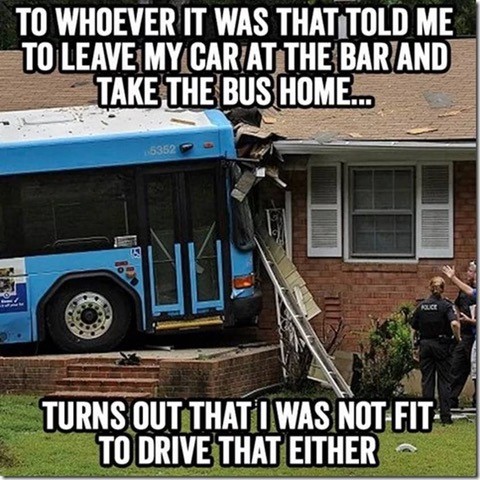
An older couple were at home watching TV. Phil had the remote and was switching back and forth between a golf channel and a porn channel. Becoming more and more annoyed Sally final said, For goodness sake, Phil...leave it on the porn channel... you know how to play golf.
